In this article, I'm going to be talking about customer success as a growth driver. I hope that what I share is going to be relevant to your daily lives and that it sparks some interesting discussions amongst those in the CSC community.
Defining the value of customer success
Let's get started with the big question we need to address: relationships or outcomes. There are two schools of thought in customer success. One argues we should focus on building relationships; the other prioritizes achieving outcomes.
In my opinion, and I feel very strongly about this, customer success needs to go beyond making our customers happy. Our customers expect us to help them to achieve their desired outcomes. That’s a big thing. If we don't help them to achieve those outcomes, they will simply go and find other solutions. In short, the relational aspect is very important, but it's not enough. We need to go beyond that if we want to keep our customers not just happy but also successful.

From the customer’s perspective, customer success is the sum of experiences that your customers have along their journey with you and the business outcomes they achieve with your product. Those experiences include every single touchpoint that the customer has with your company, whether that’s with you, sales, or customer support. It really is a team sport.
Business outcomes could include various things from cost reduction to increased revenue to higher customer satisfaction. Your customers all care about different things; what's important is to not just acknowledge their targets and the outcomes they want to achieve, but to co-own those outcomes and take responsibility for delivering them together with your customers.
How to measure client outcomes
Because this article is about driving revenue, we’re going to focus more on the second part of the customer success equation: business outcomes. Let's start by looking into the things that we can and should measure on the customer side.
- Deployment – Our aim should not just be to deploy the product successfully, but also to make sure that the customer is set up on the fast lane to success.
- Engagement – We need to engage with our customers in a meaningful way, enabling both parties to get clarity and value from discussions. It’s also important that we engage with all levels of the customer organization so that we can see the big picture of what’s going on at their end.
- Adoption – It’s important that we know if the customer is using our product and the depth and breadth of their usage.
- ROI – We want to make sure that the customer is getting the value they expected from our product.
- Growth potential – It's not enough to drive customers to get value out of our product; we need to proactively work on identifying new growth and expansion areas that they can have with us.
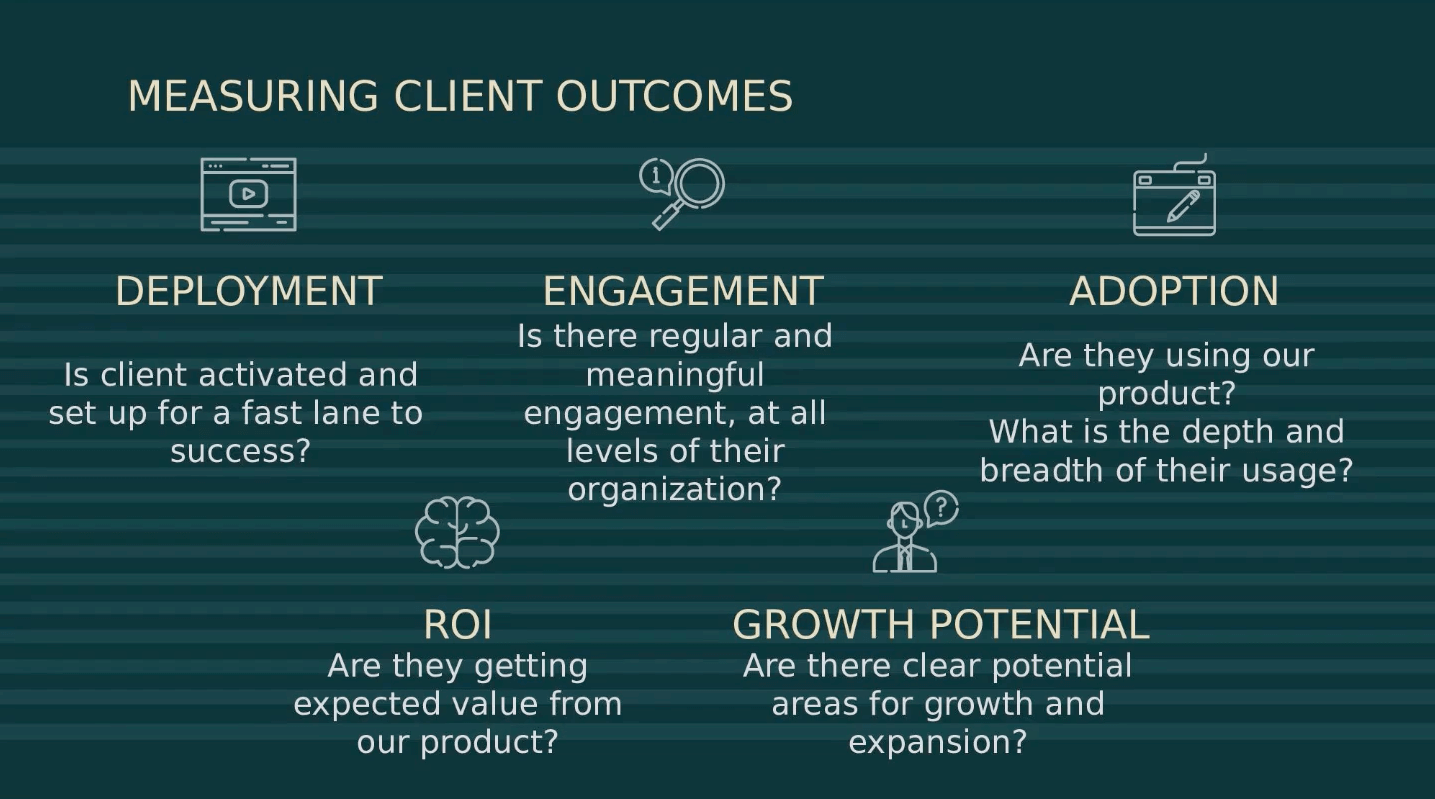
Customer success from an internal perspective
Now let’s turn the lens inwards and look at how to create a revenue model that we can use and share internally. This is about measuring the contribution that our team makes to the business.
As you know, the old way of managing revenue involved marketing and business development bringing in leads, then passing them to the sales team, who would do their best to close the deals.
In the modern revenue model, leads come in at the very beginning and at the very end of that funnel. In a way, it's not even a funnel anymore; it’s a helix, as Allison Pickens outlines in the book she co-authored with Nick Mehta, The Customer Success Economy: Why Every Aspect of Your Business Model Needs a Paradigm Shift (2020). If you haven't read it, please do. She's an amazing leader in the customer success industry.

To understand her helix model, we need to look at where the revenue comes from in a recurring revenue business. If you do the math, you’ll find that a lot of it comes from your existing customer base. That means if you want your SaaS business to grow and be profitable, you can’t just count on new logos. There comes a time when your existing base becomes larger and more important than new business; that’s when you need to get to grips with the helix model.
The model is all about understanding what it means to have a successful customer. One successful customer provides three types of leads:
💫 The first lead is their renewal, which protects your existing annual recurring revenue (ARR).
🤝 The second lead is any expansion from that customer.
🙌 The third big lead is their advocacy and willingness to champion your product to bring you new logos. They might bring you one new customer or five; either way, it’s a cheap source of potentially exponential growth.
Measuring outcomes for your business
Now let’s look at the KPIs we need to measure to prove our business impact. These can be broken down into six main areas:
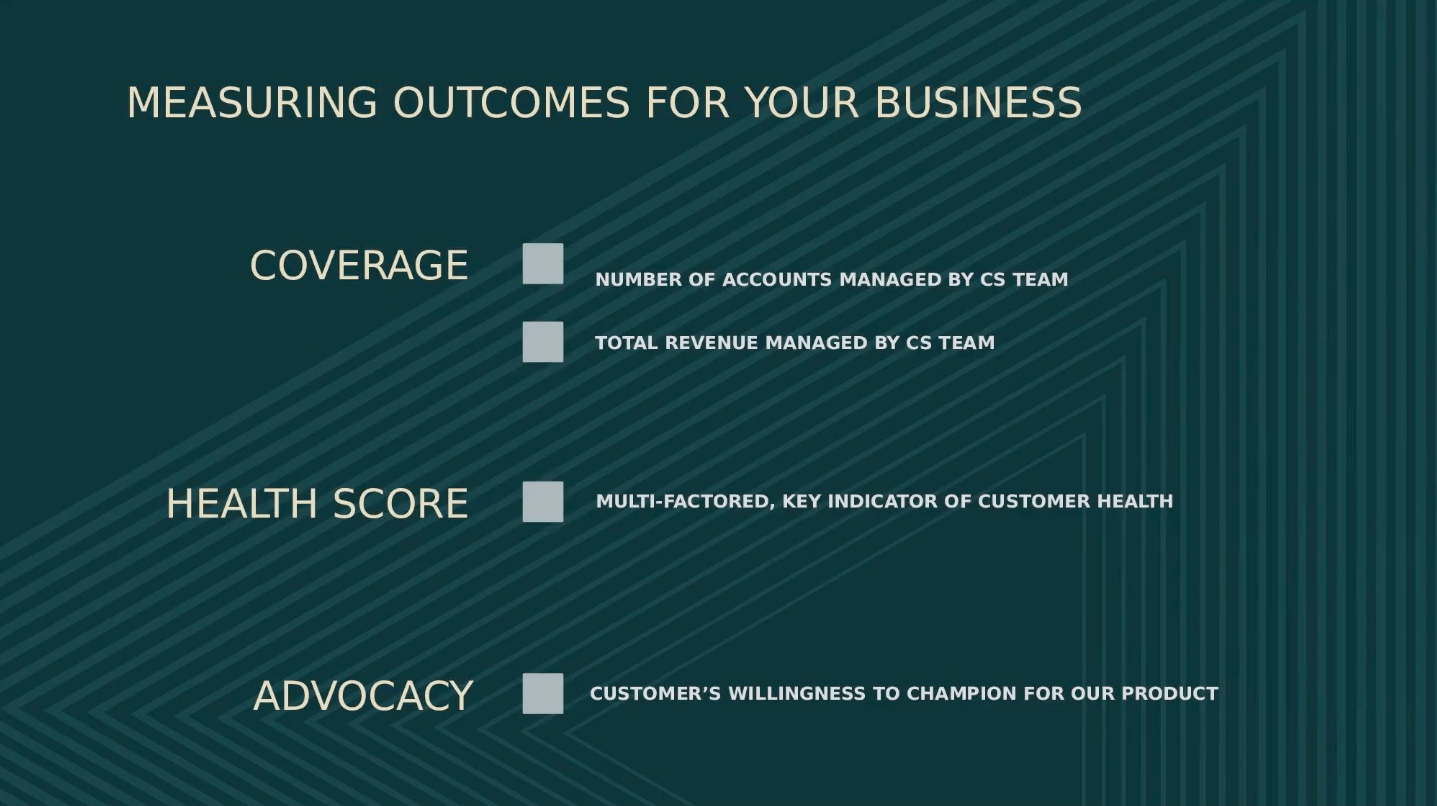
- Coverage – This is the number of accounts and the total revenue managed by the CS team.
- Health score – This multi-factor indicator varies between organizations. When you're just starting out, it will probably take the same factors into account across your customer base, but as you mature, you should develop more specific customer health scores for each segment.
- Advocacy – As we mentioned before, we also want to measure how many new leads we're getting out of our existing customer base and how many of our customers are willing to champion for us.
- Renewals – There are two metrics we want to look at here: gross dollar renewal rate and logo retention rate.
- Expansion – This involves tracking the net dollar retention rate, which takes into account the eligible ARR for renewal in relation to your new contract value. It also encompasses expansion, down-sell, and churn.
- New logos – This is a pretty exciting thing to measure. In the same way that the business development team tracks the number of leads they bring to the sales team, we should be tracking and measuring the leads that are coming out of the existing customer base back into the pipe.
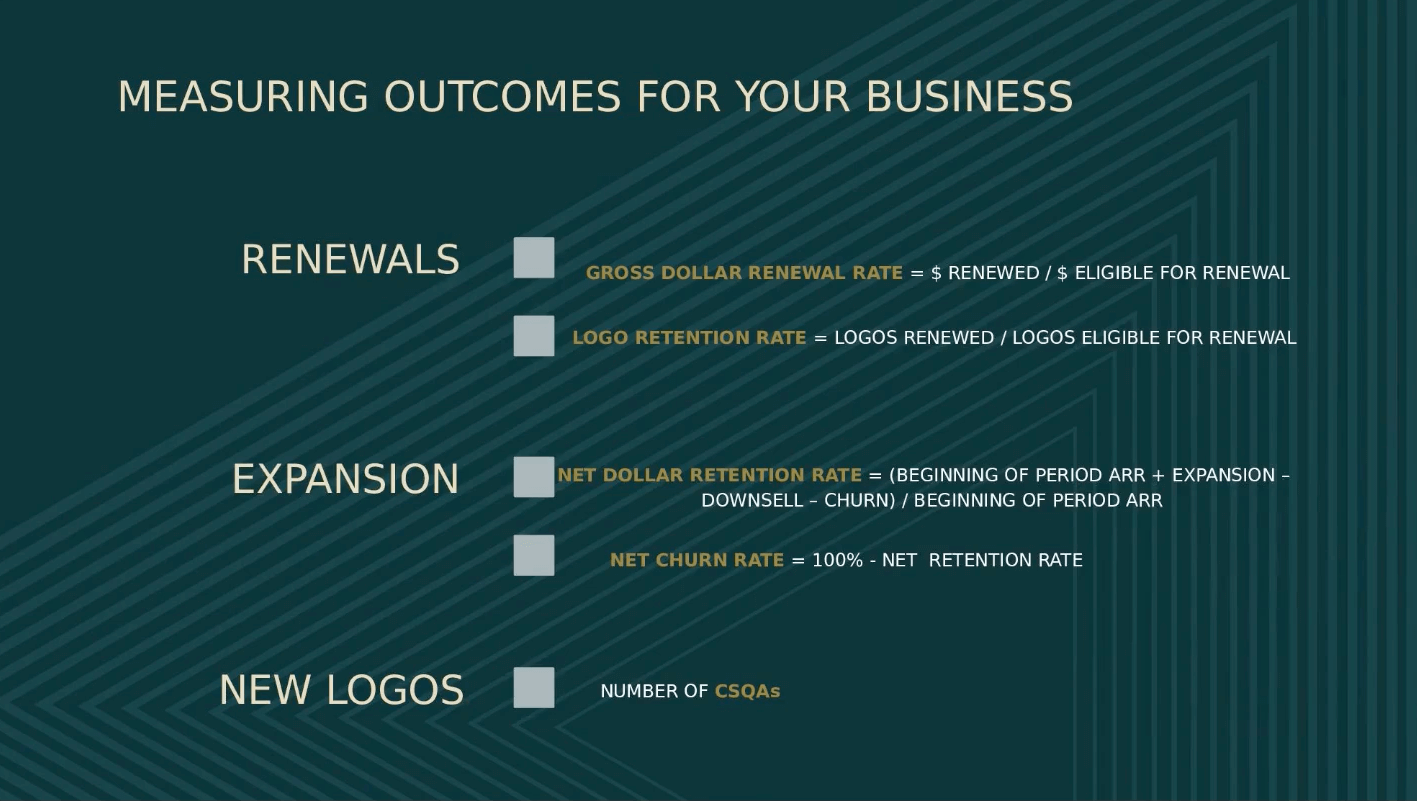
How to do it right
Being able to measure all these different ways we contribute to the business sounds amazing, but we all know that in reality, it’s extremely hard to put everything into action at once. These tips should help you get on the right track:
- Start with a few metrics – You don’t want to overwhelm your team with a lot of data points, so focus on understanding what matters and start reporting on that.
- Don't wait for perfect data – The data is never going to be 100% perfect. The sooner you start, the faster you’ll be able to build a robust data model and extract more data as you go.
- Focus on actionable insights – We don’t just want to gather signals, but also respond appropriately.
- Calculate averages and benchmarks – These will be useful not only internally but to show your customers where they stand in relation to their peers and competitors.
- Pay attention to the absence of data – It’s usually a signal that something is not going well. If, for example, a customer is not responding to your NPS survey, they might well be a churn risk.
- Mix and match your data sources – Remember the parable of the blind men and the elephant, where they’re all touching different parts of the animal and thinking it's a different thing? Well, it's the same with your data. If you want a clear picture of what's going on with your customers, you need to integrate a range of data sources, including support tickets, CRM data, and marketing insights.
- Automate where possible – This is going to make it so much easier for you to gather cohesive data that can be easily accessed by your team.
How to generate revenue with CS
Now let’s get into the meat of this article – the strategies and tactics you can use. I want to start by outlining the biggest enablers of revenue growth:
- Customer segmentation
- The customer journey
- Methodologies
- Retention
- Expansion
- New logos
At first blush, the link between all these areas and revenue growth may not be obvious, but bear with me and I’ll show you how to make them work for you.
Customer segmentation
There are a million different ways to slice and dice your customer base, but the most important thing to understand is why you’re doing it in the first place. The number one reason to segment is that it allows you to generate value from 100% of your customer base.
Of course, you have limited resources, so you can't do everything you might want to with every one of your customers, so the best way to go about it is to split your customer base into logical components, then you can decide how you want to treat each segment, allocate resources accordingly, and achieve the most optimal ROI on each segment. Basically, segmentation is a way for you to work smarter and get more money out of your existing customer base.

At Blue Prism, we’ve segmented our customers based on two parameters: total account value and potential account value, where we also take into account intangibles like reputational value. This gives us four segments, which we’ll approach with high, medium, or low-touch engagement.
For every segment, we know the main goal, the KPIs we're going to measure, the key risks we're going to monitor, how we're going to treat the voice of the customer, what kinds of Customer Success Managers will work on those accounts, the engagement cadence, and how we’re going to deliver business value.
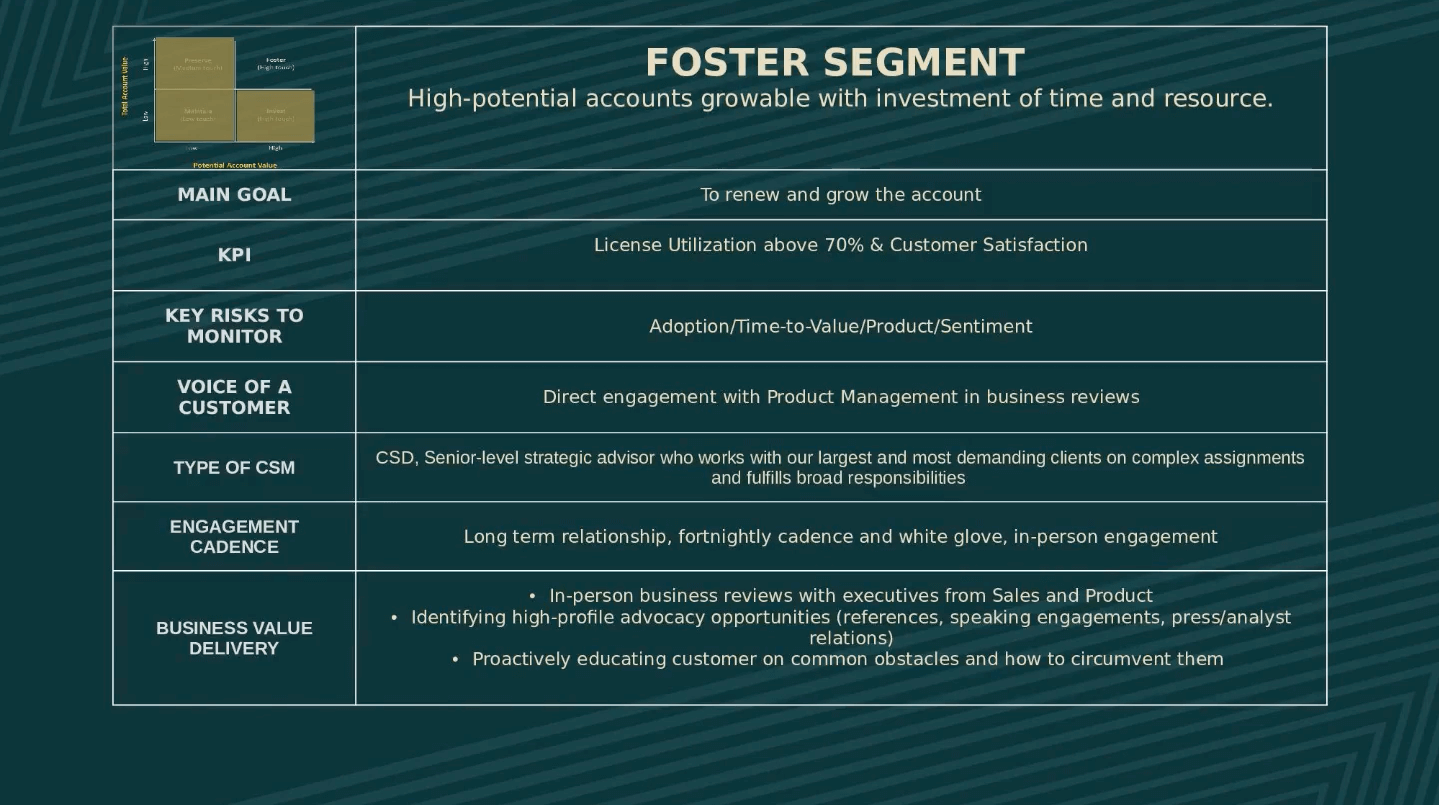
This helps on multiple levels. One important level is that it gives us a way to align all of our teams, especially the sales team, on what is expected from that customer and what kind of customer-facing approach we're going to take. That removes a lot of confusion from internal conversations.
Understanding the journey
Understanding all the stages in your customer journey can be tough. Of course, you can start with a more generic approach that covers onboarding, adoption, engagement, upsell, and so on, but it won’t make much impact on your customer if you do. What makes the difference (and requires a lot of hard work) is paying attention to what is happening with your product.
You need to understand what it takes to get customers onboarded, the key factors that will help them to succeed with adoption, the key milestones between one phase of the lifecycle and another, and much more. It takes a lot of rigor from all of your customer-facing teams to gather that data and piece it together to form a complete picture of the customer journey.
At Blue Prism, we started by looking into how the organization, outcomes, and capabilities change across the main stages of the customer lifecycle. Next, we mapped in all of the things that are happening on the customer side. That helped us to get a clearer idea of what’s happening with our customers, and to detect some of the key milestones we can track to gauge the progress that someone is making along their journey.

This type of framework is only going to help you understand what's going on; it's also going to completely transform your sales cycle by allowing you to take a much more prescriptive approach. You can go to your customer and say, “Here's what we propose as a target state, and here are all the steps we can guide you through to get you there.” That completely changes the game. You’ve switched from selling your product to selling a strategic partnership.
Methodologies
Methodologies are crucial in determining everything you do to drive value. I’m going to share the most influential methodology we’re using right now.
The first step is to understand our customers' objectives and ambitions beyond just the tactical level. We want to understand where their company wants to go and how our technology can contribute towards those objectives.
Next, we make sure that customers attach measurements to each of those objectives. Customers are often not aware of what they need to measure, so we need to be a little prescriptive in helping them to attach measurements to their goals.
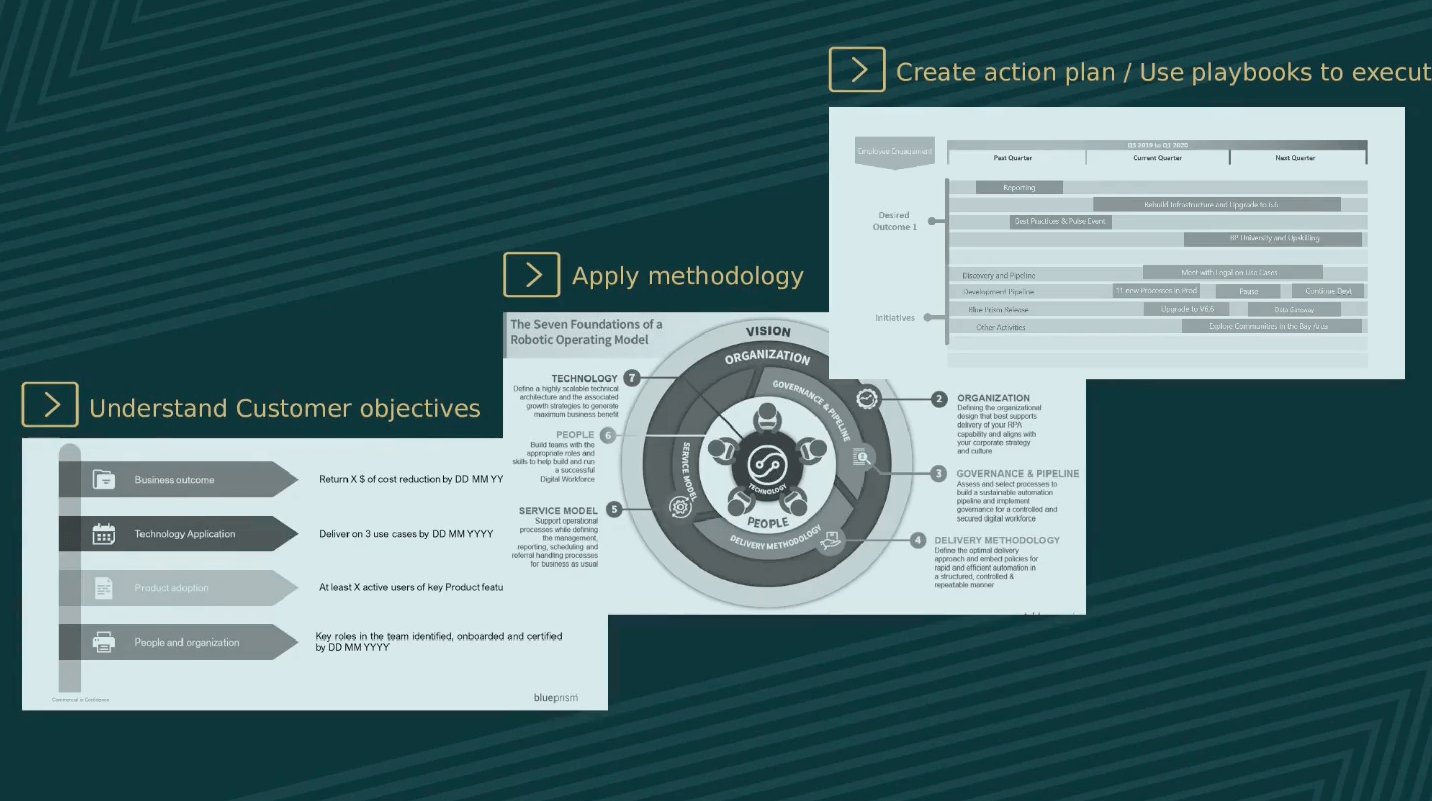
Now comes the methodology. The one that we're using in Blue Prism was built on 20 years of experience. It's award-winning and it works like magic. It involves looking not just into our product, but the overall operating model on the customer side. We're looking into their vision, organization, governance, pipeline, use cases, delivery methodology, how they manage their people, and their maintenance or support model.
We use this methodology not just to decide on best practices for interacting with our customers, but also to assess their current state. We assess where they are across all the different pillars of the operating model, and we identify gaps relative to market benchmarks. Based on that, we're able to create a plan with very specific actions they need to take to achieve their target state.
The third piece of the puzzle is implementation. It sounds obvious, but this is actually a major point of failure for a lot of customer success organizations. We need to make it easy for the team by providing playbooks on how to action all of this. This is going to help you to extend customer success beyond individual contributions and make it scalable.
There are multiple teams involved in delivering value to the customer, but you want to make sure that the CS team owns this big picture. They should be supporting other teams so that they don't get lost in technical challenges and they keep an eye on the objectives that need to be achieved.
Time-to-value matters more than you think
In my experience, time-to-value (TTV) matters way more than you think. The longer your customer is struggling to find that initial value from your product, the more they lose confidence and enthusiasm for using it at all, so being very proactive in the onboarding stage is extremely important, especially when it comes to your strategic customers.
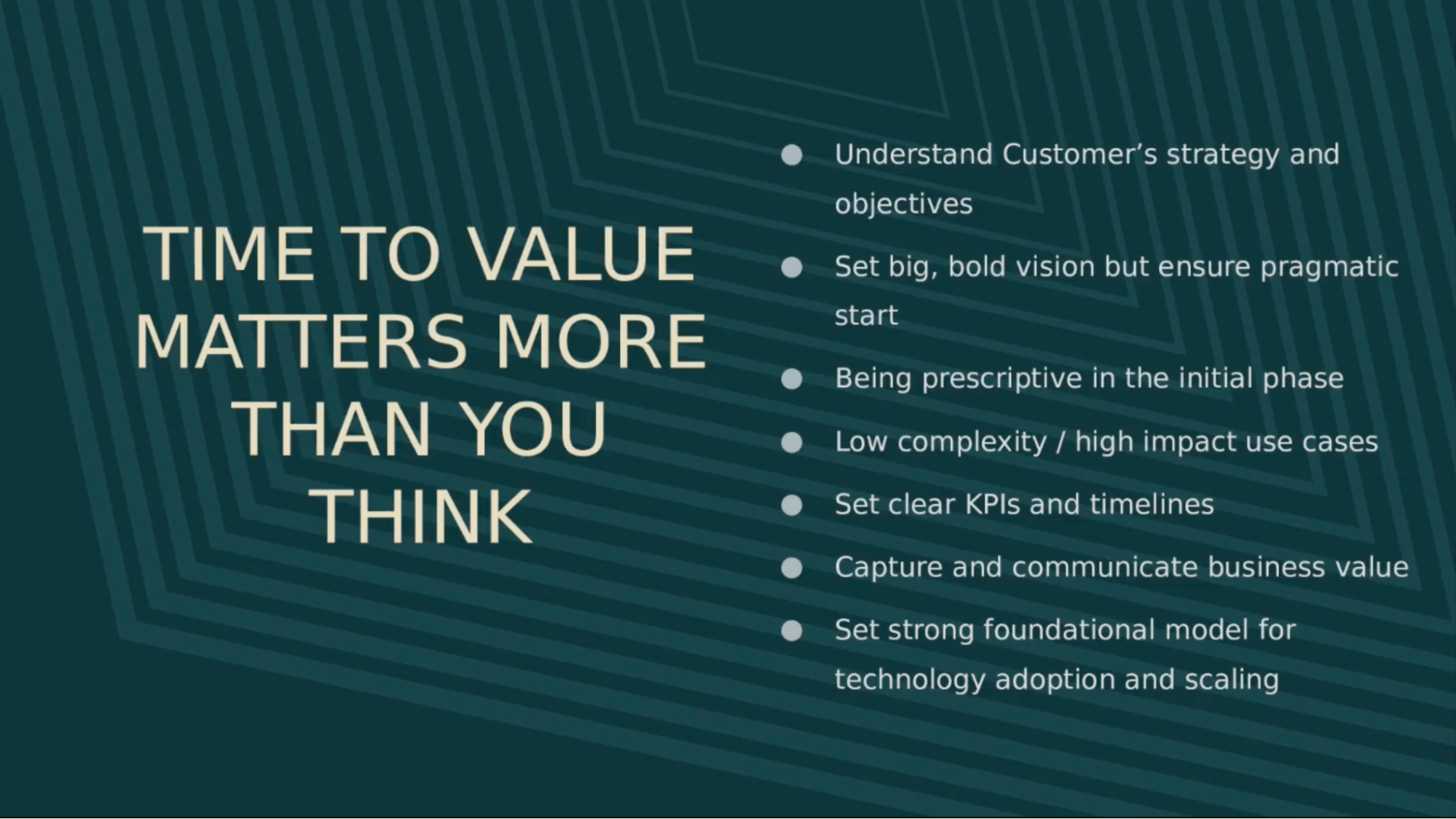
The number one failure that prevents customers from quickly achieving value from a product is choosing high-complexity, low-impact use cases early on in their journeys. They get stuck, it takes too long to get through implementation, and the value they ultimately achieve is very low.
To avoid this stumbling block, you want to proactively suggest simpler use cases that they should start with so that they get to the value as quickly as possible. Then they’ll have tangible successes to share with their management. That’s going to help them get executive buy-in to push the project forward.
Churn prevention
Once you’ve successfully onboarded your customers and helped them to succeed with your product, the next thing you need to think about is churn. The most effective way to prevent this is to gather all the signals you can to get a 360˚ view of your customer. You won't get there right away, but try to make use of whatever data you have. It’s also a great idea to talk to churned customers. Every lost client is an opportunity to learn.
I’d also recommend taking a portfolio-level view, so you can look for patterns in your churn and identify the key reasons for it. However, we need to be very careful to distinguish the symptoms from the cause. It's very easy to say that we lost the account because an executive sponsor left, but in reality, it could be that you didn’t onboard improperly or your users didn’t get the value fast enough. You need to go deeper to understand the true causes of churn.
Once you’ve identified these patterns, you need to act on them. Talk to your CSMs, product, and support, and give them a playbook on the steps that will help them to address a potential churn. This makes everyone's life much easier, and it puts your teams in a much better position to react promptly and in the right way.
Finally, remember that preventing churn is a team sport. It’s the responsibility of the whole company, so make sure that it's not only your team that takes care of it. Everything you learn about churn needs to be fed back to your product team, your marketing team (if there are issues around messaging), and your sales team (if they need to tweak how they're positioning and selling the product). This is a crucial feedback loop.
Creating opportunities for expansion
Let’s look at a couple of key components of strategic expansion.
The first and most important one is the pipeline. At the very beginning of the pipeline, you can proactively suggest use cases for your technology, but as your client scales, you might not be able to do that, so you have to find a way to set up a self-running demand generation mechanism for them.
At Blue Prism, we do that by creating a discovery mechanism for the client, which puts our product in the hands of their business users. That way, we can ensure that demand for the product comes.
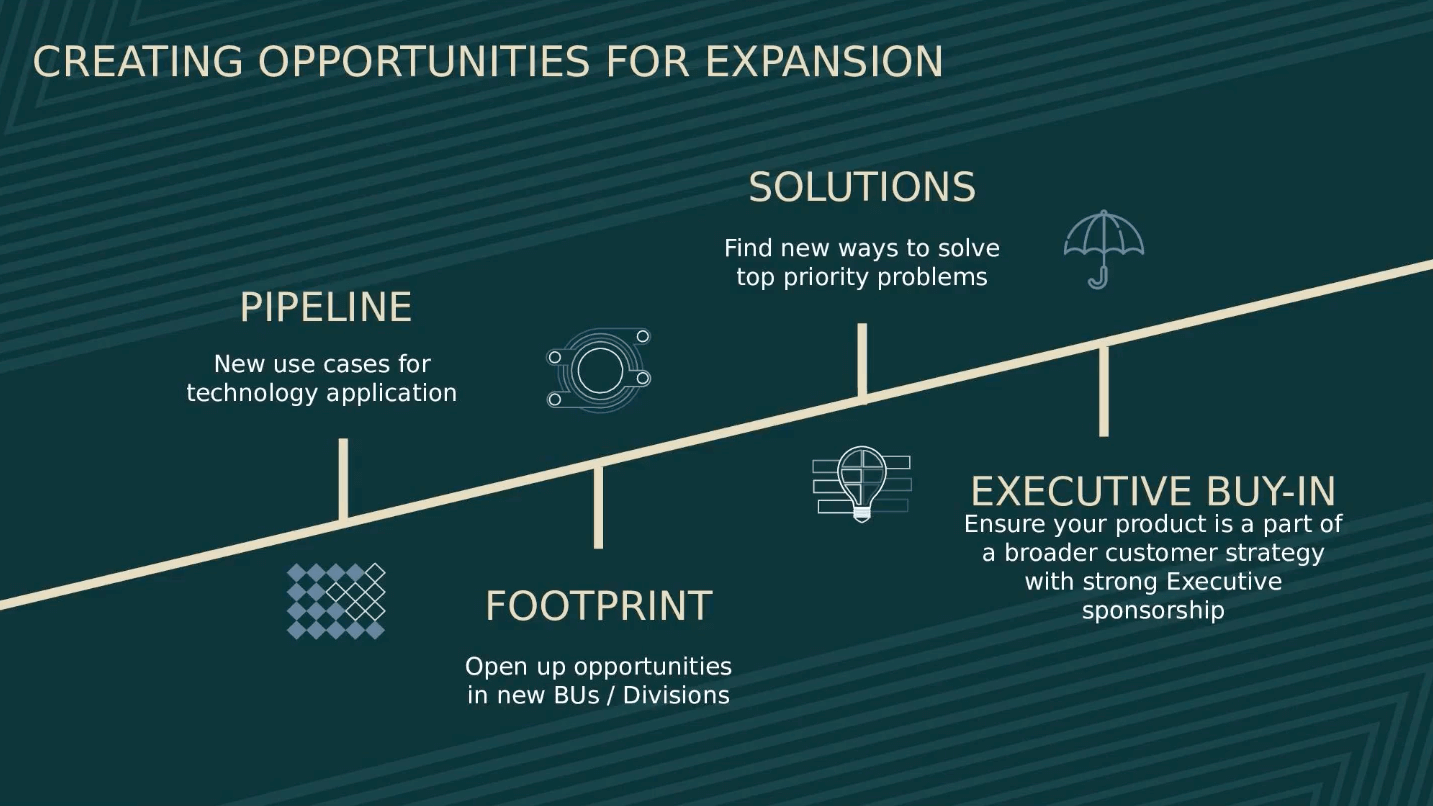
The second thing to consider is your footprint. If you want to drive expansion, you want to make sure that you're not stuck in one division or one team. We do a lot of business development activities to help our clients to evangelize our product within other divisions of the same company or group. That way, we’re owning growth and expansion together with our clients.
On the technology side, you need to keep your eyes open all the time for existing problems that you can solve with your new product features, as well as new problems that you can address with your product.
Lastly, you need to pay attention to executive buy-in. If you don’t have it, that can be your biggest obstacle to expansion. Your first touchpoints with the client might be at the user level, but it’s your responsibility to go up the chain and get that executive buy-in. This will allow you to propel your program into something more strategic and transformational.
New logos
When it comes to securing new logos, you want to make sure that your customers are ready to champion your product. Then, you should count and measure these leads and report back to your leadership on them because they are an important part of your contribution to the company’s revenue.
The second thing you need to do is gather their testimonials and success stories, but I don’t need to tell you that – you’re already doing it.
The third part of nurturing new logos is getting your team engaged in the pre-sales cycle, where they can help to create confidence that you're not just selling a product; you're selling a partnership and a journey to your customer’s target state.
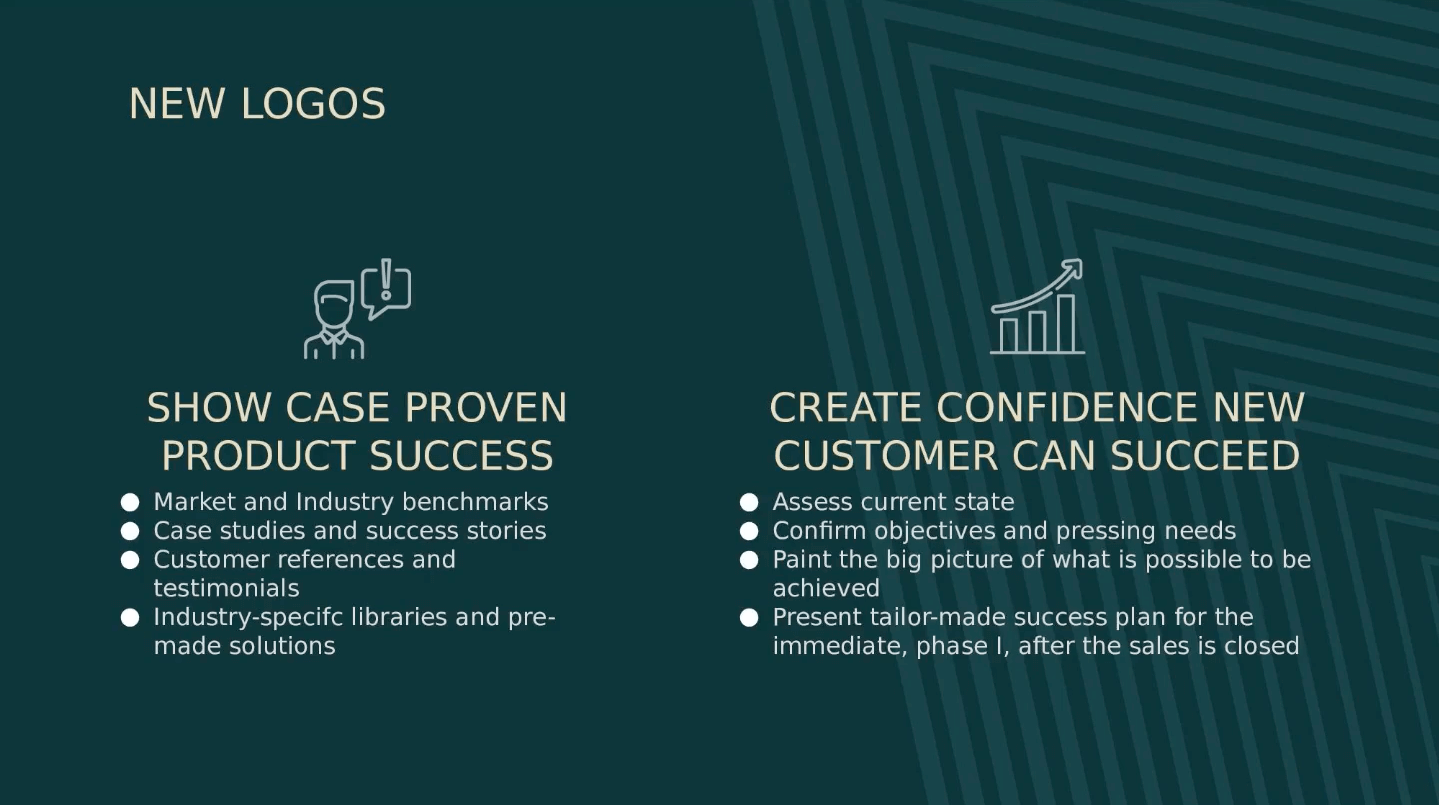
Finally, I just want to share a little bit about myself and my background. I was born and raised in Serbia, but I’ve lived and worked across Europe, the US, and Asia.
I've held regional and global roles in marketing, product, partnerships, and customer success – yes, that's a lot of different fields! I’ve worked both in corporate and startup environments, and I think all this variety has helped me to learn a lot about how to both build and scale businesses.
Throughout my career, my philosophy has always been to focus on the customer and to drive growth. In my role, that means driving growth for customers, employees, and strategic partners, and going beyond financial growth to make sure that we’re giving back to the community in a meaningful way. Therefore, Tech for Good is a big deal in my career and an underlying pillar of what I'm striving to achieve.
Right now, I’m with Blue Prism. Before that, I was working across different tech verticals, starting in telecommunications, then moving over to ad tech and customer data platforms. Right now, I focus on intelligent automation and applied AI, and I'm currently helping Blue Prism strategic customers in the Asia Pacific (APAC) region to build and grow the value of their digital workforce.
Did you enjoy this article?
As we mentioned at the start of this article, this piece was transcribed from a presentation Jovana gave at our first-ever Customer Success Festival APAC back in October 2021.
If Jovana's article sparked joy (Marie Kondo fans unite!) or it gave you some food for thought, why not experience the real deal in real-time and attend one of our Customer Success Festivals – either in-person or virtually?
Whether you’re tackling customer onboarding, churn mitigation or renewals, rest assured, you’ll leave our festival rejuvenated and ready to return to work to apply your findings.




 Follow us on LinkedIn
Follow us on LinkedIn



